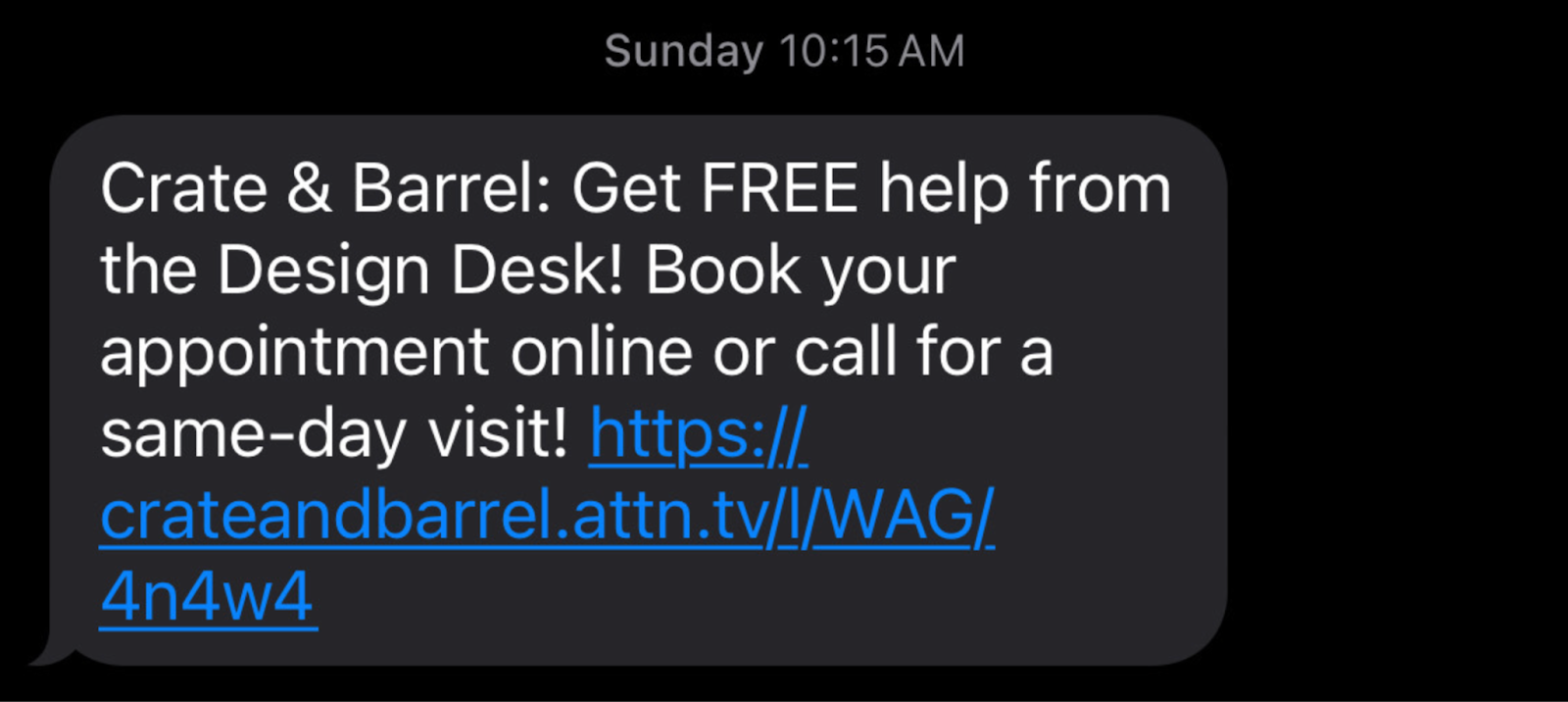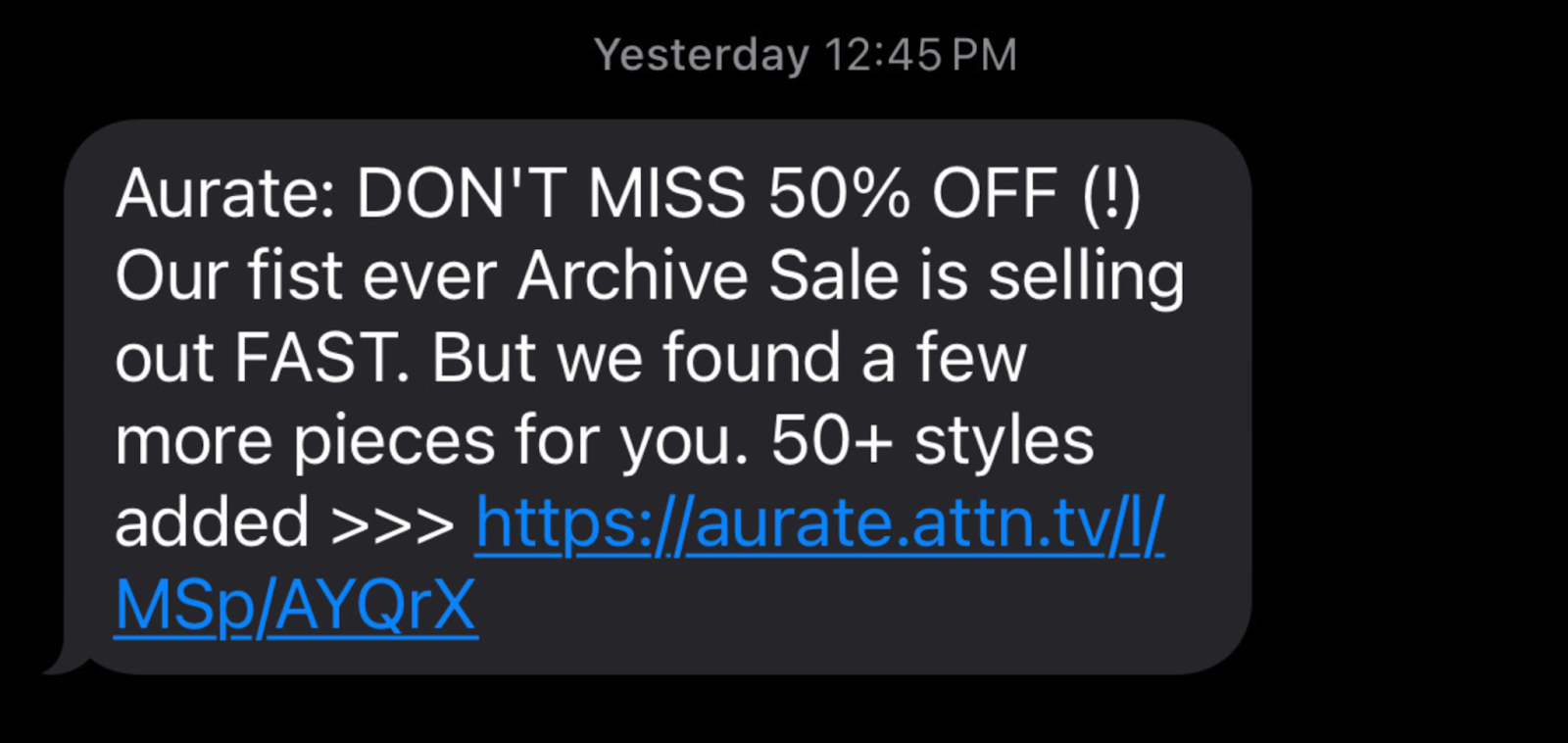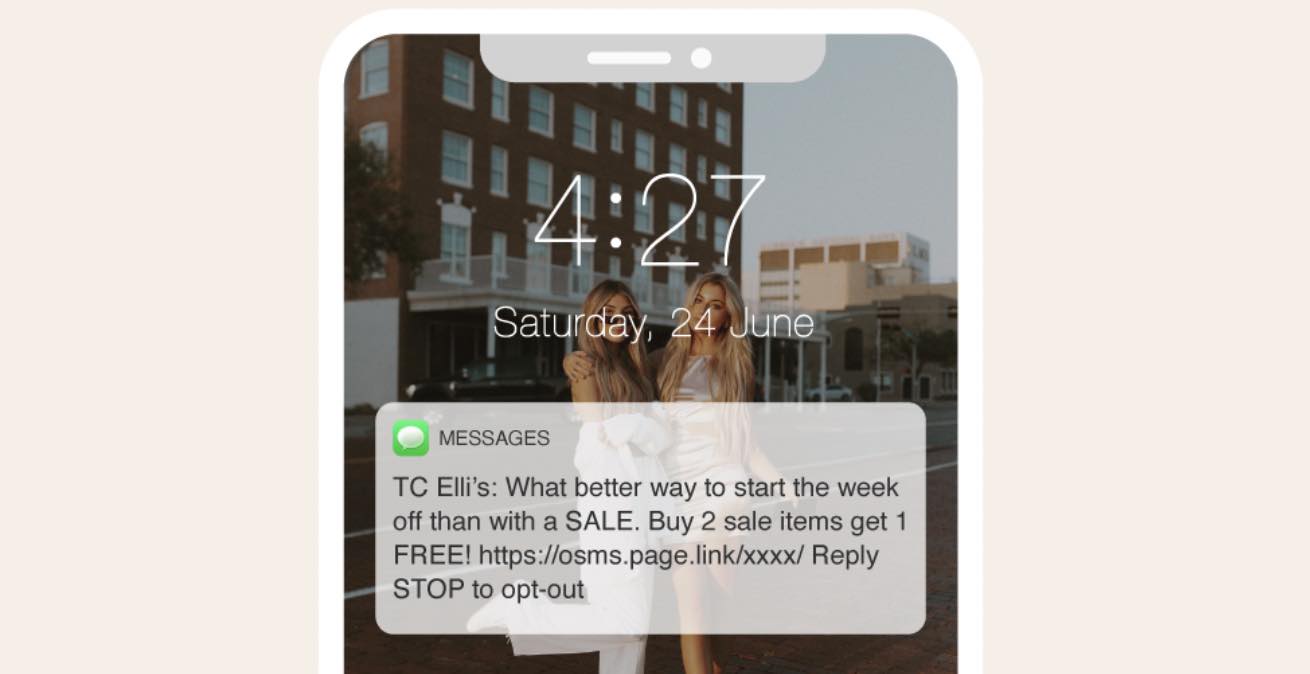
Marketing your business can take up a ton of time and resources. As a retailer, it can be difficult to gain traction through your marketing efforts due to social media algorithm updates and the sheer volume of emails that most people receive daily.
SMS marketing, also known as text message marketing (or just text marketing), is a simple way to reach your customers and get a much higher ROI. Customers welcome it, too—with 70% agreeing that it’s a great way for businesses to get their attention.
In this article, we’ll go over:
- What is SMS marketing
- Benefits of SMS marketing
- How to use SMS marketing
- SMS marketing laws and compliance
- SMS marketing strategies to try
- Measuring the success of your SMS marketing campaigns
- Examples of successful SMS strategies
Let more customers find you
More people than ever are looking to shop local businesses by searching on Google. Our free guide gives you actionable tips on how to make your business more discoverable on search engines.

What is SMS marketing?
Short message service (SMS) marketing is a form of marketing that businesses use to send promotions to customers via text messages. In other words, SMS marketing is the same thing as text marketing.
Like email marketing, SMS marketing is opt-in, which means customers need to sign up for it. However, unlike email marketing, SMS messages are much shorter (and more likely to be engaged with sooner than emails—more on that later).
Is SMS advertising effective?
SMS marketing is effective when your messages are crafted thoughtfully and sent to the right customers—just like any marketing!
But is SMS advertising specifically effective enough for its effort to be worth your time? We think yes. Cell phone adoption is nearly universal, with 97% of US adults owning one. And they’re deeply engaged with their phones: a survey of business owners found that their customers were 4.5x more likely to reply to an SMS message than an email.
This isn’t to say SMS marketing should replace your emails—the longer text emails allow will always have a place—but SMS messages are a good supplement to a larger strategy, especially if you segment your customers carefully, such as by purchasing behavior or location.
Benefits of SMS marketing
SMS marketing has several advantages over other forms of digital marketing.
It’s fast
Text message marketing is fast in more than one sense. Unlike social media or email marketing, you don’t need to design any images to go with your content. Text messages also have a low character limit, so you don’t need to write a ton, either. They’re quick and easy to produce and send.
Secondly, texts can reach your recipients faster than an Instagram post or email would. Your customers receive instant notifications on their phone when they get a text. Comparatively, they would need to take the additional step of opening a social media app or email client to see your other forms of marketing.
It has near-perfect open rates
If you want people to open your messages, sending them by text is the most effective way to get them to do so.
Marketing texts are opened a whopping 98% of the time, which is about as close as you can get to a full 100%. By comparison, a study by Mailchimp found that the average open rate for a retail marketing email is only 18.39%.
It gets high response rates
Since SMS open rates are high, its response rates are high as well. The average response rate for an SMS marketing message is 45%, whereas email click-through rates don’t normally break higher than 7%. Customers are significantly more likely to click on a link you send through text versus email.
How to use SMS marketing: best practices
SMS marketing doesn’t have to be complicated. In fact, it’s even easier than email or social media marketing since there’s no design component required.
Here is what you’ll need to do to get started with SMS marketing:
Get a list of customers you have permission to message
In the US and Canada, it’s against the law to text people that have not given you explicit permission to do so. Before you send an SMS advertising campaign, make sure your list of recipients has given you the okay to send messages. Remove anyone who you cannot confirm their permission status.
Loyalty software can help you collect customer info and ensure you remain compliant.
Use a tool to send your messages
You’ll need software to help you automate your sms marketing—you don’t have time to manually email every customer, after all. There are some services that solely provide text message marketing, but you could also opt to use an integrated system like Lightspeed Advanced Marketing.
A separate SMS marketing system would require you to upload a list of customer contact info and would track your campaign data separately from all of your other marketing initiatives. The benefit of choosing a loyalty program that integrates with your POS system is that you can collect info, manage data and send your campaigns from the same place you take sales.
Craft your message
Your texts don’t need to be as long as an email newsletter. In fact, the shorter the better. Try to stick to about 160 characters, which is about a sentence or two.
In your message, quickly identify yourself so your customers know who you are. Then, let them know why you’re messaging them—are you offering them a deal? Asking them for a review or feedback?
Finish off your message with a clear call to action and, if applicable, a link.

Reach the right customers at the right time
Someone who lives near your flagship location and spends big there every month will be receptive to different messaging than someone who shops online only and only makes purchases around the holidays. Likewise, a happy customer will be open to different marketing than an apathetic or upset one.
By segmenting your customers into buckets by behavior, you can maximize your impact. To save time and ensure your buckets are always accurate, use a tool (like Lightspeed Advanced Marketing) that draws on POS data to automatically sort customers into segments for you.
Track results
After you’ve sent a message, track its performance. If you included a link in your message, see how many people clicked on it. If you made a special discount code that’s exclusive to your SMS advertising campaign, see how many people used it when they made a purchase and how many sales you generated. Compare these figures to the number of messages you sent.
Don’t just track. Track effectively. Manually tracking results can eat up a lot of time. SMS marketing tools like Lightspeed Marketing & Loyalty can automatically generate reports for you so you spend less time compiling data and more time acting on it.
Give customers a way to opt out
You should include a way for your customers to opt out if they are no longer interested in receiving SMS messages from you. Not only are opt outs required by law, the option to opt out shows you’re engaging in good faith. You don’t want to spam, you want to connect.
SMS marketing laws and compliance
Here’s a warning for you: venturing into SMS marketing does mean navigating a complex web of laws and compliance requirements, which can vary significantly by industry and region.
Key to this is understanding the regulations around consent. Customers must explicitly opt in to receive messages, a rule that’s universally stringent but applied differently across locations. For instance, the United States enforces the Telephone Consumer Protection Act (TCPA), while the European Union is governed by the General Data Protection Regulation (GDPR), both mandating clear consent and offering easy opt-out options.
Each industry may also face specific guidelines, especially where sensitive information is concerned, such as in healthcare or finance. Retailers must ensure they’re not only acquiring consent correctly but also sending content that is appropriate and relevant to their audience.
For tobacco and alcohol retailers, SMS marketing laws are especially stringent due to the sensitive nature of these products. Both industries are highly regulated to prevent advertising to minors and to ensure that marketing messages are sent only to those who have explicitly consented and are of legal purchasing age. Due to these strict regulations and rulings by CTIA, many marketing platforms do not allow SHAFT—sex, hate, alcohol, firearms or tobacco and CBD—messages to be sent at all, so some retailers might find jumping the hoops not worth it.
Here’s a breakdown of what you need to keep in mind:
- Explicit consent: customers must provide clear, explicit consent to receive marketing messages. This often involves a double opt-in mechanism where the customer not only agrees to receive messages but also confirms their consent through a subsequent verification step.
- Age verification: retailers who want to send SMS messages about age restricted products must implement robust age verification processes both at the point of opt-in and purchase. This ensures that marketing messages and sales are legally compliant, targeting only those of legal age to purchase tobacco or alcohol.
- Responsible messaging: retailers need to be sure they’re not crossing a line. Marketing content must not encourage excessive or irresponsible consumption of alcohol or tobacco. Messages should be crafted responsibly, adhering to ethical standards and regulatory guidelines.
- Health warnings: depending on the region, there may be requirements to include health warnings in marketing messages for tobacco and alcohol products, or any health and weight loss products.
- Local laws: regulations can vary significantly by region. For instance, some areas might have complete bans on advertising tobacco products via SMS. Some states have extra regulations you need to consider: California, for example, doesn’t let you record SMS messages to customers without explicit consent, and Florida doesn’t allow SMS marketing between 9 PM and 8 AM local time.
For comprehensive and up-to-date information on SMS marketing laws, retailers should consult legal experts in their specific region or industry. Resources like the Mobile Marketing Association provide guidelines and best practices to help navigate these waters safely.
SMS marketing strategies to try
Welcome texts
Similar to a welcome email, try sending a welcome text after a customer signs up for your loyalty program. You can even offer a special discount for new sign-ups to encourage them to shop again with you.
New product arrivals
As soon as you add new arrivals to your storefront or website, use an SMS advertising campaign to let people know that they can start shopping. This is an excellent way to drive traffic and buzz for new items. We suggest doing this once a season—otherwise you may run the risk of spamming your customers.
Flash sales
Flash sales are a great way to reward customers who have signed up for your loyalty program. Let your customers know there’s a limited-time sale that only they can access via SMS.

Giving them a first look or making a sale exclusive to them is a fantastic way to show that you value their business.
Seasonal sales
When it’s time to clear out your inventory, send a text to your customers letting them know about your seasonal sale.

Consider segmenting your sends by specific groups to send more targeted messaging. For example, text a link to your shoes that are on sale to customers that have bought shoes from you in the past. An SMS marketing platform connected with your POS will make crafting segments easier, as you’ll have easy access to sales data.
Ask customers to fill out surveys
Surveys are a great way to learn more about what your customers expect from you. To increase your chances of getting a high response rate, try sending a survey link through SMS instead of other marketing channels. You can easily create a short survey with tools like Google Forms or SurveyMonkey.
Cross promote your social media accounts
Growing your business’s social media accounts can be a full-time job in itself. Leverage your SMS marketing audience by sending a text message encouraging them to follow you on social media. Combining this with a social media-based giveaway might help to sweeten the deal.
Measuring the success of your SMS marketing campaigns
Measuring the success of SMS marketing campaigns is crucial for understanding their impact and optimizing future efforts.
Key performance indicators (KPIs) for SMS marketing
First, you need to define your success state. To do that, you need to track KPIs specific to your SMS messages.
The top key performance indicators to focus on include:
- Delivery rate: measures how many of your messages successfully reached recipients. A high rate indicates good contact list health, while a low rate indicates you need to prune your list and remove old numbers.
- Open rate: since SMS open rates are generally high, this metric helps gauge immediate engagement—remember that marketing texts are opened 98% of the time, so your SMS open rate benchmarks should be much higher than your email open rates.
- Click-through rate: the percentage of recipients who clicked on a link in your SMS. It’s vital for assessing the effectiveness of your call-to-action. If you have a 98% open rate, but 2% click-through rate, you need to do some work. Aim for around 30%.
- Unsubscribe rate: this helps identify how many people opt-out after receiving your SMS, indicating the relevance and quality of your content.
Tracking SMS marketing ROI
Tools for tracking these KPIs range from specialized SMS marketing platforms to integrated marketing software that includes SMS tracking capabilities.
These tools not only measure performance, but can also provide insights into SMS marketing benchmarks, helping you understand how your campaigns compare to industry averages.
Tools and techniques that can help include:
- SMS marketing platforms: many SMS marketing platforms offer built-in analytics features designed specifically for tracking the performance of text message campaigns. These platforms can provide real-time data on delivery rates, open rates, click-through rates, and conversion rates.
- URL shorteners and tracking: using URL shorteners like Bit.ly in your SMS messages can not only save precious characters but also enable tracking of click-through rates. These services typically offer analytics on how many times the link was clicked, from which geographic locations, and even the type of devices used. This data can be invaluable for understanding engagement and the effectiveness of your call-to-action.
- Integration with CRM and analytics tools: integrating your SMS marketing platform with Customer Relationship Management (CRM) systems and web analytics tools (like Google Analytics) can provide a deeper understanding of how SMS campaigns contribute to your overall marketing objectives. By setting up tracking for specific conversion goals, you can see how recipients move from a text message to performing a desired action on your website.
- A/B testing: to optimize the effectiveness of your SMS marketing, employ A/B testing by sending different versions of a message to segments of your audience. This can help you understand which message variations perform best in terms of open rates, engagement, and conversions. Many SMS marketing tools support A/B testing, providing data that can guide your content and strategy decisions.
Examples of successful SMS marketing strategies
SMS marketing doesn’t have to be complicated—even one or two well-timed text messages can make a difference.
To make sure your SMS marketing strategy is as effective as possible, take cues from retailers who have seen success with theirs.
Using SMS marketing to get the word out about new offerings: Pinjarra Bakery
Pinjarra Bakery is known for exclusive, one-off savory pies. While they had been relying on word of mouth and email marketing to get the word out, targeted SMS marketing offered Pinjarra the chance to inform their most loyal customers of exclusive pies right away.
On paper, the strategy was simple: around lunchtime, send a marketing SMS about new one-off pies to their most loyal customers. This meant that these customers had a chance to try exclusive pies first, which has two benefits:
- Loyal customers are customers who have already been won over. They don’t need as much extra convincing to come in and try an exclusive pie, they just need to know there’s one available at the right time.
- A loyal, happy customer is more likely to promote a business. By having loyal customers try new pies first, they can amplify the message through word of mouth.
Just two of these simple but effective SMS campaigns contributed to 15% of Pinjarra’s revenue over a 3 month period.
Using SMS marketing for hyper-specific targeting: T.C. Elli’s
Marketing is most effective when it hits customers at the right point in their customer journey. By drawing on data from their POS system, T.C. Elli’s sorted their customers into buckets:
- Lost customers
- At risk customers
- Best customers
- Promising customers
- New customers
- Loyalty program members
Each of these buckets has slightly different behaviors and desires; lost and at risk customers need different messaging than loyalty program members and big spenders.
For example, when T.C. Elli’s launches a promotion like a buy-2-get-1-free sale, they send a quick marketing SMS message to their most engaged customers (the best, loyalty program and promising buckets).

These customers are most likely to already be engaged with T.C. Elli’s, while an SMS message is more likely to be seen quicker (and in full) compared to an email. This gives these messages the highest chance of success.
Reach your customers wherever they are
Your customers spend a ton of time online and on their mobile devices. With SMS marketing, you can easily reach them with short and sweet offers en masse.
Your SMS marketing campaigns will be the most effective if they’re building on customer behavior data—and the best way to get that is by connecting your SMS message platform with your point of sale.
But that’s not all Lightspeed does for retailers—from inventory management to on the sales floor, Lightspeed streamlines retail so you can do more. Watch a demo to learn more.
Frequently asked questions about SMS marketing
Does SMS marketing really work?
Yes, SMS marketing is highly effective due to its direct nature and high engagement rates. With over 90% of text messages read within three minutes of receipt, it offers unparalleled immediacy and visibility compared to other channels.
What is the market for SMS marketing?
The market for SMS marketing spans various industries, including retail, services and healthcare, targeting consumers who prefer quick, concise information. It’s particularly useful for time-sensitive offers, appointment reminders, and direct customer engagement.
Most adults in the USA own smartphones, so the potential market size for your SMS messages is massive.
Is SMS marketing expensive?
Compared to traditional advertising, SMS marketing is cost effective, with expenses varying by provider and volume. Bulk SMS packages can significantly reduce per-message costs, making it accessible for businesses of all sizes. Average cost per message is often between $0.015 to $0.06.
When should I use SMS marketing?
Use SMS marketing for urgent announcements, exclusive promotions, appointment reminders and personalized alerts. It’s most effective for reaching customers instantly and driving immediate action.
Is SMS marketing illegal in the USA?
No, SMS marketing is legal in the USA, but is regulated under the TCPA and requires explicit consent from recipients. Marketers must provide opt-out options and adhere to privacy and consent rules.
What are the disadvantages of SMS marketing?
While SMS marketing has many pros, it also has a few drawbacks. Limitations include:
- message length restrictions
- potential for higher opt-out rates if messages are too frequent or irrelevant
- the need for compliance with legal regulations, which can be complex
Do people like SMS marketing?
Yes, people often like SMS marketing. When done correctly and with consent, many people appreciate SMS marketing for its convenience and personalization. One report found 71% of customers surveyed had opted in to receive texts from a business.
However, receptiveness can vary based on the content’s relevance and frequency.
Is email or SMS marketing better?
Neither email nor SMS marketing is objectively better; their effectiveness depends on your audience and goals.
SMS excels in immediacy and high open rates, while email provides more space for content and is better for longer-form communication. A well-rounded marketing plan will include both.

News you care about. Tips you can use.
Everything your business needs to grow, delivered straight to your inbox.


